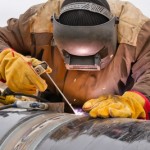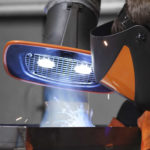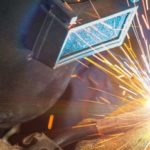Two welding methods and the related hazards
Welding activities hold a number of sources of danger: Not only the material, but also the welding procedure used are decisive in which work protection measures need to be taken and what the welder needs to look out for. Hazardous substances are not the only problem here, as examples of gas metal arc welding and TIG welding show.
Gas metal arc welding
Gas metal arc welding is the most often used version of arc welding in use. In the process, a wire electrode melts under a shielding gas cover. The gas protects the arc, the joinings and the welding seam from ambient air. If active gas is used (e.g. carbon dioxide), we speak of metal active gas welding (MAG). However, if steel is welded using inert gas such as for example argon, we speak of metal inert gas welding (MIG). The procedure is versatile. Nearly all weldable materials can be joined this way.
In gas metal arc welding, the danger due to electric current is relatively high. Unlike many other electric devices, electrode welders are not fully protected against direct contact. The insulation is interrupted at the welding point, so that the electrical circuit can be closed to smelt the metal. The voltage used can cause life-threatening injury.
A further aspect is arc radiation. The welding arc emits visible, infrared and ultraviolet rays which are more intensive and dangerous than in the case of for example gas welding. The invisible short-wave ultraviolet rays cab burn the skin and cause inflammation of the outer eye. The higher the current and current density, the higher the radiant intensity. During the process, the welder must wear an appropriate safety helmet and also watch out for reflections on stainless steel or aluminium surfaces.
TIG welding
In the case of Tungsten Inert Gas Welding (TIG), an electric arc burns between a tungsten electrode and the part. However, the electrode does not smelt in the process. If material needs to be added, this is done by hand using welding rods or mechanically as a wire using a feeding device. A nozzle is installed around the tungsten electrode concentrically through which inert gas is emanated to protect from the atmosphere. Usually, argon is used as a protective gas.
Compared with other processes, TIG welding seems to be the most low-emission at first glance, since minimum visible welding smoke builds. Nevertheless, it can be dangerous to health: Due to high electric arc temperatures, ozone and nitrous gas (nitrogen oxide) are produced. These irritant gases can cause nausea, headaches and severe lung damage. During welding of chrome-nickel-steel joins, cancer-causing hazardous substances are produced which are not noticeable with the naked eye.
When working with tungsten electrodes containing thorium oxide, the danger of exposure to radiation appears, since the electrodes contain radioactive thorium oxide. This applies above all to TIG welding using alternating current – such as for example with aluminium materials. Safe work using the TIG welding technique can be guaranteed only with the use of powerful extraction systems and particle filters.





